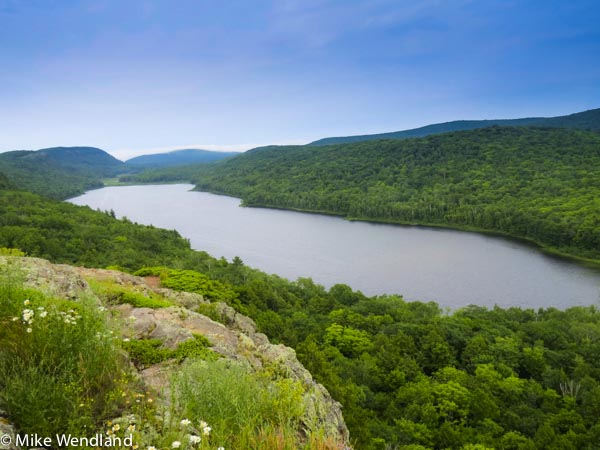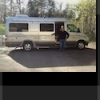Mike’s Top 5 Places to Visit in Michigan’s Upper Peninsula
 If you are a regular reader, you know Jennifer and I love to RV across Michigan’s pristine Upper Peninsula – the UP – where big towns simply aren’t, and the scenery is jaw-dropping gorgeous with lots of forests, lakes and streams and, of course, the Big Lake, Superior, which some say is the coldest, deepest fresh water lake in the world.
If you are a regular reader, you know Jennifer and I love to RV across Michigan’s pristine Upper Peninsula – the UP – where big towns simply aren’t, and the scenery is jaw-dropping gorgeous with lots of forests, lakes and streams and, of course, the Big Lake, Superior, which some say is the coldest, deepest fresh water lake in the world.
Superior borders the UP to the north. The south coast of the UP is bordered by Lakes Michigan and Huron.
We visit the every time we can, in all seasons. If you’ve never been or would like to spend more time there, here’s my suggestion for the RV Tour of the UP.
I suggest to budget 10 days for this.
And the first thing I suggest is that you try to avoid black fly season which usually starts in mid June and runs through mid-July. The black flies are most prevalent along the lake Superior shoreline but you’ll find them, and giant mosquitoes, most active during that time.
Just to show you how bad they are, check this video I did last summer.
Don’t believe it? Then check this one from the year before.
But don’t let them deter you. Just be prepared. Bring long pants, jackets and sweatshirts, too, as even in summer, it can get chilly up there.
Getting there
From the west, find US 2 from Wisconsin and just keep driving east.
From the south, Cross from Michigan’s Lower Peninsula on I-75 and the five-mile long Mackinaw Bridge.
Here are our five top suggestions about the places you should visit.
1) The Soo Locks
I’d start at the very northern end of I-75 in Sault Ste Marie, Michigan and a visit to the famed Soo Locks (Sault is pronounced “Soo”). The locks are a set of parallel locks which enable ships to travel between Lake Superior and the Lower Great Lakes. Here you will see a parade of giant lake freighters, barges, tugboats and more traverse the 21-foot drop between Lake Superior and Lake Huron every day. The Soo Locks are the busiest locks in the world, and include the largest lock in the Western Hemisphere, completed in 1968.
The two active Locks, the MacArthur and the Poe, handle an average of 10,000 vessel passages per year, which means visitors are almost certain to get a glimpse of one or more of the many ships that ply the Great Lakes. From viewing stands situated at the Lock’s edge, enjoy an up-close-and-personal glimpse of life aboard freshwater and ocean-going freighters, some of which can carry as much as 72,000 tons of cargo in a single pass.
There is something really majestic about spending a few hours watching the boats make their way through the locks. You can get so close to them you can even exchange greetings with the crewmen who toil on the big freighters.
The best place to stay if you want to watch the freighters is the city’s Aune-Osborn Campground, which lies along 20 acres of waterfront property on the lower St. Mary’s River. The western end of the park houses the camp sites. The eastern end of the park is undeveloped and is used for special events and sightseeing on the St. Mary’s River. The campground features 100 water and electric sites. It opens in mid-May. Some sites are right on the river bank but most sites offer views of the maritime traffic headed to or from the locks. This park fills up most summer nights.
A half hour west is Brimley State Park, a modern 237 site campground with electric on site and a dump station for taking on water. Located at the Southern end of Whitefish Bay, it also has a swimming beach.
2) Pictured Rocks National Lakeshore
Move west along the lake Superior Shoreline to the tiny little lakefront town of Grand Marais and the heart of the Pictured Rocks National Lakeshore.
Here’s a video.
Pictured Rocks National Lakeshore is a U.S. National Lakeshore on the shore of Lake Superior in the Upper Peninsula of Michigan, United States. It extends for 42 miles along the Superior shore and covers 73,236 acres.
Unlike any other place on Lake Superior, Pictured Rocks offers the opportunity to explore miles of pristine beaches, hike over 100 miles of trails, and experience the serenity of the northern hardwood forest. The best way to see thee cliffs is by kayak, though the shoreline hiking trails offer very impressive views, too.
Sandstone cliffs, beaches, sand dunes, waterfalls, lakes and forest will treat your eyes as you hike, paddle, camp and explore. From Munising, at the western end of the park, there are glass bottomed boat excursions that are worth taking. They usually start operation for the summer around Memorial Day.
There are National Forest campgrounds, state forest campgrounds all along the shoreline. In the tiny harbor town of Grand Marais is the Woodland Park Campground, right along the shore. It offers great beach walking and agate hunting. The campground does not take reserrvations.
Our favorite camping spots, though, are the federal campgrounds on the lakeshore. The lakeshore’s federal campgrounds are rustic and do not have electric, telephone, water, or sewer hookups. Typically there is no cell phone reception. In our Roadtrek eTrek with solar, that is no problem. The campgrounds have generator-free zones.
First choice for us is always the Twelvemile Beach Campground, about 12 miles west of Grand Marais off Alger County Road H-58. The campground’s 37 sites are located on a sandy bluff above Lake Superior’s Twelvemile Beach. The entrance road winds through a picturesque stand of white birch. Twelvemile Beach Campground also features a 2.0 mile self-guiding interpretive trail. This place fills up most summer nights so arrive mid morning.
We also like the two Hurricane River campgrounds, the Upper and Lower. They are located off Alger County road H-58 three miles east of Twelvemile Beach campground where the Hurricane River flows into Lake Superior. Eleven campsites are available in the lower campground loop, and ten in the upper loop. A level 1.5 mile walk on the North Country Trail east from the lower campground leads past shipwreck remnants to the historic Au Sable Light Station.
If you need hookups, try Muskallonge Lake State Park. located 15 miles east of Grand Marais on H-58; 28 miles northwest of Newberry in Luce County. The 217-acre park is situated between the shores of Lake Superior and Muskallonge Lake and the area is well known for its forests, lakes, and streams. The park has 170 modern campsites that feature electricity and two shower and toilet buildings.
3) Copper Harbor
Copper Harbor is located at the tip of the Keweenaw Peninsula hat just up from the western end of the UP. Hold your left hand sideways with your thumb pointing up. That’s the Keweenaw. You can’t go any further north without falling in Lake Superior. In fact, Lake Superior borders the little town of Copper Harbor on three sides. A mountain, Brockway Mountain, hems it in from the South. It is so remote that you can’t even get cell phone coverage in town. There’s one way in, US 41, which dead ends about two miles out of town.
It is one of the best spots we’ve found to take our RV anywhere in North America. Copper Harbor, with a year-round population of 90, prides itself on being far away, But what it lacks in big city amenities, it more than makes up for in outdoors fun.
Start out at the Historic Fort Wilkins State Park, tucked along the shoreline of Lake Fannie Hooe, a long inland lake loaded with trout that is just across US 41 from the pounding surf of Lake Superior. There are two loops to the park, the west unit with paved pads for big rigs, and the east unit with flat but grassy spots a half mile away. Separating the two campgrounds is Fort Wilkins, a wonderfully restored 1844 military outpost.
There is, across from the Fort a quarter mile out into the Big Lake, a lighthouse, first constructed in 1846. It, too has been restored and tours are available all day. You need to board a boat in Copper Harbor for a short ride to the lighthouse.
he town has become a mountain biking mecca, with world class trails abounding in the hilly forests that surround the town. We found mountain bikers gathered from across the country. Many are very hardcore and the trails are technical. But there are also easy rides and a great place to rent bikes right downtown. At the end of the day, the bikers all congregate at the Brickside Brewery, a very friendly microbrewry that hand crafts artisan brews.
Copper Harbor is also a center for kite surfing. We watched a half dozen wetsuit clad kite surfers scoot across the frigid waters and always roiling waves of the lake.
Also in town and well worth a hike is the Estivant Pines, a 500 acre stand of virgin white pines. Michigan, in the mid to late 1800′s was the land of white pines and the entire state was practically clear cut by thousands of rough and tumble lumberjacks. The white pine, which grows 150 feet tall, were used for sailing masts and its lumber built many a frontier town as the nation expanded west.
4) Porcupine Mountains
The Porcupine Mountains, or Porkies, as the locals call them, are a group of small mountains spanning the northwestern Upper Peninsula of Michigan in Ontonagon and Gogebic counties, near the shore of Lake Superior.
The Porcupine Mountain Wilderness State Park consists of over 60,000 acres and s contain the largest tract of old-growth hardwood forests west of the Adirondacks and is home to black bear, deer, wolves, river otters and even moose, as well as rare woodland plants that depend on the old-growth forest habitat that abounds here.
Visiting the virgin forests, free-flowing rivers and undisturbed beaches of the Porcupine Mountains Wilderness is like taking a step back in time. There are great hiking and mountain bike trails here and hundreds of waterfalls, secluded lakes, wild rivers and streams.
Our favorite spot is the Presque Isle River Campground, on the western end of the park.
It has 50 sites and about half are generator free. This is quiet. You can sometimes hear wolves howl at night and most of your neighbors are in tents, campers or small RVs.
If you must have power, then try the Union Bay Campground, located at the opposite end of the park. Union Bay campground is the largest campground in Porcupine Mountains Wilderness State Park. It offers modern bathrooms and showers. The campground borders a rocky and scenic section of Lake Superior in the eastern portion of the park on the way to Lake of the Clouds on county road 107.
But don’t expect a wilderness experience at Union Bay. It is a busy, noisy and crowded state park. This where where the Big Class A RVs seem to go.
5) Tahquamenon Falls
At 50,000 acres, the Tahquamenn Falls State Park stretches for over 13 miles and is centered around the Tahquamenon River and its waterfalls. The Upper Falls, one of the largest waterfalls east of the Mississippi has a drop of nearly 50 feet, more than 200 feet across and a water flow of more than 50,000 gallons per second. Four miles downstream is the Lower Falls, a series of five smaller falls cascading around an island. Although not as dramatic as the Upper Falls, they are equally magnificent. The falls can be viewed from the river bank or from the island, which can be reached by rowboat rented from a park concession. The island walk affords a view of the falls in the south channel.
This is the land of Longfellow’s Hiawatha – “by the rushing Tahquamenaw” Hiawatha built his canoe. Long before the white man set eyes on the river, the abundance of fish in its waters and animals along its shores attracted the Ojibwa Indians, who camped, farmed, fished and trapped along its banks. In the late 1800′s came the lumber barons and the river carried their logs by the millions to the mills. Lumberjacks, who harvested the tall timber, were among the first permanent white settlers in the area.
Rising from springs north of McMillan, the Tahquamenon River drains the watershed of an area of more than 790 square miles. From its source, it meanders 94 miles before emptying into Whitefish Bay. The amber color of the water is caused by tannins leached from the Cedar, Spruce and Hemlock in the swamps drained by the river. The extremely soft water churned by the action of the falls causes the large amounts of foam, which has been the trademark of the Tahquamenon since the days of the voyager.
There are two excellent campgrounds here, one at the Lower Falls, and one at the mouth of the Tahquamenon River where it empties onto Lake Superior, east of the tiny UP town of Paradise. The Lower Falls campground has two loops with 90 spots in each. The Rivermouth campground has 36 spots. Electricity s available and flush toilets in the restrooms.
Our favorite time to camp here is winter. The state plows out a good number of sites and although the water is out in the winter, the solitude and beauty make it absolutely spectacular.
There is snowshowing and cross country skiing in the winter and a four mile trail runs from the Upper to the Lower falls.
This park gets crowded on the summer. The state does take reservations, without which, you’l be lucky to get in during peak time on weekends and holidays.
So much more
There is so much more to see and experience by RV in the UP.
The Les Cheneaux Islands. The Lake Michigan shoreline. The Seney National Wildlife Area. Whitefish Point. The Huron Mountains.
But I promised to share my top five suggestions. Maybe I’ll do a follow up report later on my next five.
See why I suggest 10 days as a minimum time for your visit?



0 Comments
Recommended Comments
There are no comments to display.
Please sign in to comment
You will be able to leave a comment after signing in
Sign In Now